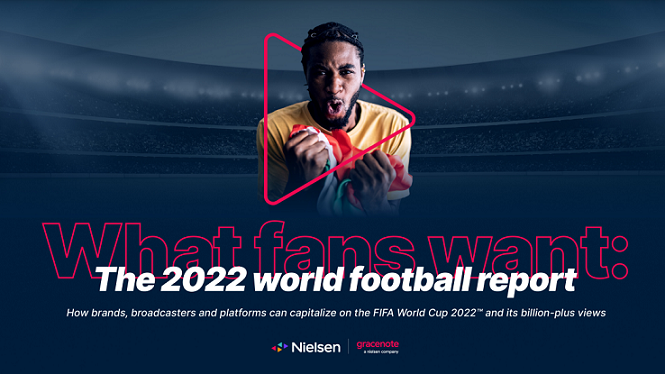
The FIFA World Cup 2022™ is a football fan’s paradise. Over 28 days of play, they’ll watch 32 national football teams compete in 64 matches, culminating in a final game that hundreds of millions of people will watch.
For an event as momentous and emotionally charged as the World Cup, many fans will even reconfigure their sleep patterns so that they can watch the games in real-time. Even with the rise of streaming and on-demand content, live TV is viewers’ preference.
The experience extends far beyond the matches—spilling out into the streets and taking over fans’ screens and feeds. But with so much happening, the competition for eyeballs is almost as intense as the battle for possession on the field. The entire media ecosystem—from the broadcasters, streamers and platforms to the brands and rights holders— needs a precise understanding of who’s watching, how they’re watching and what they care about across all regions and demographics.
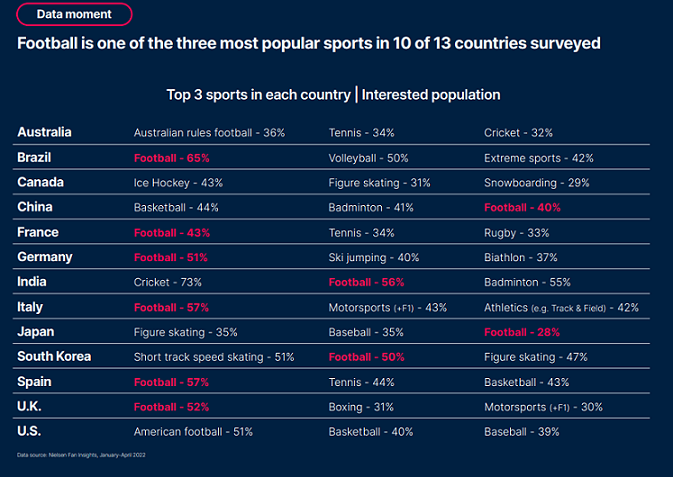
This report delivers that, helping media players create the ultimate World Cup experience and helping marketers capitalize on the extraordinary content and sponsorship opportunities.
Football remains the world’s most popular sport, generating powerful interest in 40% of the global population.It was one of the three most popular sports in 10 of the 13 countries3 we analyzed, which include the world’s top 10 economies.And of the countries where football did not rank in the top three—Canada, Australia and the U.S.—it did rank in the top 10.
Football audiences cross demographic lines, including income, education and profession. Fans are of all ages, although they’re more likely to be under 50 and over-index on income versus the average person. And while, overall, more men watch football than women, women’s interest in the World Cup dwarfs all other major international football competitions. The UEFA European Championship ranks second in popularity, but female interest in that drops by 13 percentage points when compared to the World Cup.
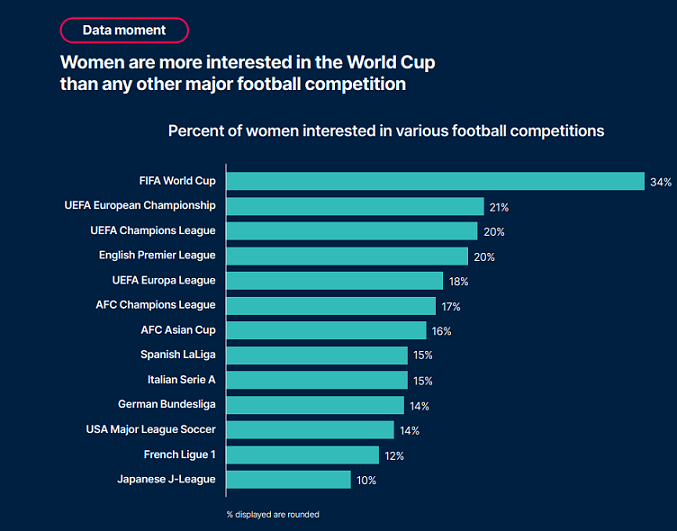
Currently, 37% of global football fans are women.
Given their keen interest in the World Cup, it could be the right moment to prioritize speaking directly to this cohort and turn potentially casual fans into loyal ones through more thoughtful content and sponsorship integrations that surround the matches. For instance, this year is the first time the World Cup will overlap with the festive holiday season for much of the world, and women are often key holiday season spenders. So, there’s a natural bridge for brands, broadcasters and platforms to deliver holiday-related messages, content, services and merchandise directly to this audience while capitalizing on the halo of World Cup excitement.
Given the sport’s growing appeal, rights holders and content providers are increasing access to it, amplifying the World Cup buzz.For football fans who watch sports, free-to-air TV is the most popular option, while 62% pay to watch8, 72%9 tune in via social media and 68%10 view on over-the-top (OTT) streaming devices. This means brands, publishers and platforms can get creative with how they engage audiences across multiple devices.
For example, in May of 2022, TikTok announced it would be the official partner of the UEFA Women’s EURO 2022. The partnership lets TikTok users access exclusive behindthe-scenes footage from the tournament, amplify their own video content with dynamic effects, and reinforces the platform as a go-to space for all things football fandom.
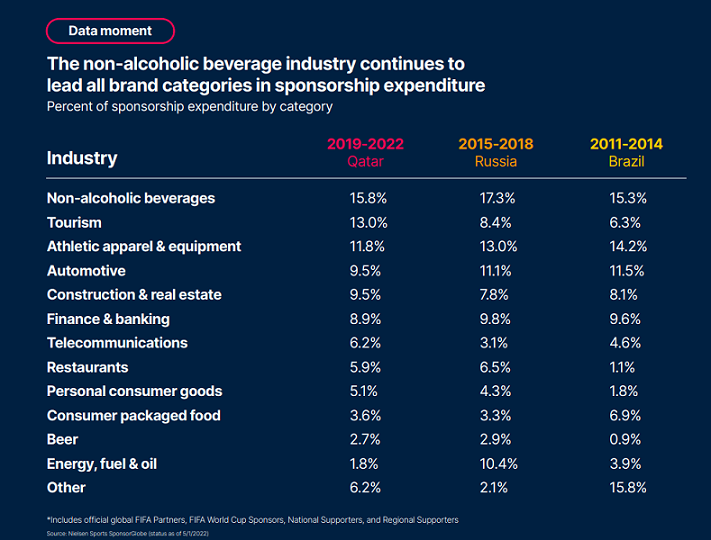
Looking to the major markets in Asia, at least 50% of people in both India and South Korea are interested in football. This level of interest is matched only in Brazil, Germany, Italy, Spain and the U.K. among the nations we survey monthly. This tells only part of the story in Asia, however.
The level of interest in football in Southeast Asia is massive despite the fact that none of the countries in this region have traditionally qualified for the World Cup finals. In three of the four most populated Southeast Asian countries—Indonesia, Vietnam and Thailand—well over 50% of the population in each is interested in football. The sport is also popular with over 50% of the population of the sixth most populated Southeast Asian nation, Malaysia.
Globally, the World Cup has the highest awareness of any sporting event—95%12 of sports fans, on par with the summer and winter Olympics. Perhaps unsurprisingly then, half of sports fans are willing to pay for live/on-demand coverage of the World Cup, more than any other sports broadcast.
Good as gold:Sports sponsorships perform
Brand sponsorships are critical for clubs’ financial success. FC Barcelona recently signed a deal with Spotify that included naming rights at Camp Nou and shirt placement for the next three years. The price? US$64 million per season. Brands are also an important part of the viewing experience. Even in an era of endless distractions, viewers are paying attention to sponsorships. Fifty-six percent of football fans actively inform themselves about brands engaged as a sports sponsor, and 67% agree that companies involved in sports sponsorships gain in appeal with the audience.

Beyond the pitch: Meeting fans where they are to create an immersive experience
How fans interact with a global event like the World Cup is going to be as diverse as they are. There are behavioral differences between countries and between fans and nonfans, meaning brands and marketers need extensive data to make sure they’re actually reaching the right audience. In many places around the world, there’s already a deep tradition of large-scale, close down-the-street-type events. These are highly coveted spaces for brand activations. For example, in Berlin, the watch parties include collaborations with radio hosts and sponsors giving out free branded merch.
Perhaps unsurprisingly, Germany had the lowest percentage of fans who said they’d watch the 2018 World Cup on their phones—just 4%.21 These live events are likely to catch on more in North America, which will be hosting the 2026 World Cup across 16 host cities. While the die-hards may be glued to the game on their TV or smart device, others are busy multitasking. Of football fans who watch sports, 69% are likely to order food while watching, 67% may be checking their email, and 60% might play an online game.Globally, 42%of fans are interested in live-betting on football while watching, and in countries like Australia, France, and the U.S., the number is closer to 50%.
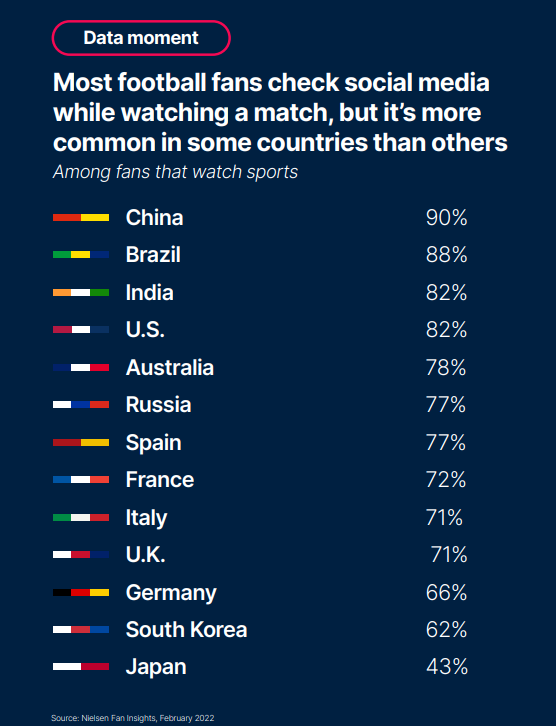
What fans want: 4 takeaways for the 2022 World Cup
1.The world’s sport still has room to grow
• Female football fans are more interested in the World Cup than any other major football competition. There’s an opportunity through World Cup coverage, content and sponsorships to help turn casual female fans into loyal ones.
• Asian populations and brands continue to emerge on the World’s stage. Football popularity is strong across Southeast Asia in countries with massive populations, which means that brands that capitalize on the opportunity will be well placed to reach and convert new fans in the region.
2.Data drives modern sports viewing
• Fans expect reliable, real-time data that contextualize and enhance whatever match they’re watching. This is particularly true in events like the World Cup, where one game’s outcome can impact the position of several other teams.
• When properly structured, data integrations within the viewing experience can help fans find more of the World Cup content they want, when they want it. Of the football fans that watch sports, 80% are on their device while watching a match—and they’re likely to want a lot of content.
3.Sports sponsorships win big among fans
• Football fans are more likely than the general population to be influenced by sponsorship, affecting how they perceive a brand and what they’re likely to buy.
• The non-alcoholic drinks category continues to spend the most on sponsorship (by percentage), but tourism sponsorships have made a big jump since 2018.
4.Divided fan attention means opportunities for immersion
• The overwhelming majority of fans are multitasking on their devices while watching a match. This means there are even more possibilities to integrate sponsors and engage with fans during the World Cup.
• The World Cup isn’t just a televised event. It’s the opportunity for a fully immersive experience, and the savviest broadcasters, brands and platforms will capitalize by providing content in all the places fans want to consume it.


